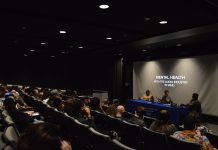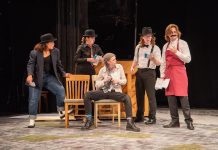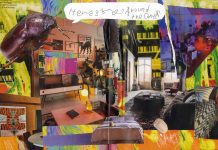The Webster University dance department hosted the BFA fall 2 dance concert “Something About Women” at 7:30 p.m. Nov. 1 and 2 and 2 p.m. on Nov. 3 on Stage III in Webster Hall. The performance gave four senior dance majors the opportunity to choreograph, as well as perform in, their own creations.
Lorraine Stippec
Lorraine Stippec said her time in the Webster dance department got off to a “rocky start.”
Stippec spent her freshman year taking the core classes necessary for a dance major. She had just undergone ankle surgery and was not able to dance her first year.
Heading into her sophomore year, a car accident left her with a shoulder injury. The healing process lasted the entire year. However, she was still able to perform and dance. She had surgery on her shoulder the summer before her junior year.
“It was a rough start, but I got through all that and was able to get right back on track,” Stippec said.
In November of Stippec’s junior year, she was diagnosed with Lupus.
“It was tough to figure out whether I should continue with dance or not,” Stippec said. “Health-wise, I needed to figure out if it would be a wise decision. I need to be able to handle the stress of performing and choreographing, but the disease is highly affected by stress, fatigue and joint pain. These aren’t good things to have as a dancer, but I made it here. I managed to get through it and I’m graduating early in December.”
Stippec said her professors were able to help her make up the classes she missed, and everyone in the department was very understanding.
“Those couple of months, getting through the end of fall semester junior year was a little rough,” Stippec said. “I got to the spring semester and I managed to perform in the spring concert that year. I spent the summer getting back on track, and this year has been going great so far. I’ve been dancing for the most part. It’s just been on and off and all over the place.”
Stippec had three pieces in “Something About Women.”
Her group dance entitled “The Elephant in the Room” was inspired by the roles of families with alcoholics.
“‘Elephant in the room’ is a common American phrase used to describe something that’s an issue and very obvious, but everyone is avoiding it,” Stippec said.
Each dancer had a specific role: the enabler, clown, lost child, scapegoat, family hero and the alcoholic.
“The clown makes everyone laugh. The enabler takes care of the alcoholic. The child gets lost in the midst of everything and the scapegoat is a rebel and the family hero pretends that everything is OK and becomes successful in getting people to think that their family doesn’t have problems,” Stippec said.
Journaling led to the inspiration for the trio “Atargatis, Thessalonike & Ariel.”
Stippec said she keeps a journal to document things and inspire her throughout her time studying dance and choreography. The journal entry that inspired the piece was a recollection from her childhood summers.
“When I wrote this entry, it was close to summer and I just wanted to go swimming,” Stippec said. “I wrote about a memory that I had. When I was a little kid I used to put a scrunchy on my ankle and go swimming in the little pool in my backyard. I thought it would be fun to explore what it would be like to have that on stage. It was very out of the ordinary but it was fun to do, and the all the girls worked really hard.”
Stippec’s solo piece, “Concealment of Protruding Ambiguity,” was based on the book “We Need to Talk About Kevin” by Lionel Shriver. The novel was made into a film in 2011.
“I have not seen the movie,” Stippec said. “I tried to make myself not watch it so I wouldn’t get sidetracked from the book. I didn’t want to get any different ideas or any visual help with it. I knew I needed to create it in my own mind.”
She took quotations from the book and had her mother, Susan, record them.
“I thought it would be sentimental and helpful while I was choreographing to have someone who actually is a mother be able to help speak the phrases. It was nice to incorporate her and she liked the end product,” Stippec said.
Joselyn Renae Simms
Simms’ piece, “Structural Support,” was the first performance of the night. The dancers were accompanied on stage by six ladders of different shapes, sizes and positions.
“The inspiration is simple, I do a lot of aerial dance at Webster,” Simms said. “I love to climb on things and I’ve always been a monkey on the monkey bars. I wanted to incorporate that daring and athleticism into the piece.”
Simms also choreographed “Standards.” Gender roles and the standards society can put on people inspired the piece. Simms said these standards can relate to gender as well as relationships. She wrote the piece last year for a composition class, but felt as though it wasn’t complete. The duet tells the story of a relationship between a man and a woman.
Simms’ solo, “Cynthia,” is an ode to a distant relative, with elements of maternal strength. She said it was also inspired by her friend who is a single mother.
“Sometimes motherhood can be a burden, but other times it’s a blessing,” Simms said.
Her great-great-great- great-aunt, Cynthia Ann Parker, was a pioneer from Illinois who went through many hardships in her time.
“Her family built a fort called Fort Parker and it was raided by Comanche Indians,” Simms said. “She was kidnapped by the Comanche when she was 9 years old. Then, she lived with them for 25 years.
“While she was living with them, she married a chief and had three children. To get Cynthia back, the pioneers raided the tribe and re-kidnapped her. They killed her husband in front of her and took the children. The pioneers forced her to go back with them. She died of a broken heart.”
Simms is set to graduate in December because of extra credits she took in high school. Currently, she has an internship with The Big Muddy Dance Company in St. Louis. She is also working on a media literacy minor in order to pursue public relations as well. Simms said she has learned a lot from professors and dancers at Webster.
“It’s really been a period of self discovery,” Simms said. “There was a time when I wanted to quit dancing completely. Living the life of a dancer, a dance student and a professional dancer is hard, both mentally and physically. I’m so glad that I stuck with it, I don’t regret it. Dancing at Webster has been a blessing, and I wouldn’t have done it any other way.”
Sarah Harris
Although Sarah Harris didn’t make it into the dance program until her second audition her sophomore year, she still managed to finish the credits and will graduate with her bachelor of fine arts in dance with emphasis in modern dance.
Her duet was a Merce Cunningham piece. Cunningham was an American experimental dancer. He used a style of choreography called chance procedure. He would take non-traditional approaches, like rolling dice to choose dancer placement. He also worked with a musician named John Cage, who would write the music for choreography, but neither one would converse until the night of the performance when they put the music to the dance.
“I used the chance procedure inspired by Cunningham,” Harris said. “I had the choreography made and I chose from a pile to see what would come next. The music is all John Cage and I didn’t listen to any of it, I just gave the sound designer some CDs and said, ‘Pick one to play Thursday, Friday and Saturday night.’”
Harris wrote the text for the sound score of her solo, “Skeleton Diaries.” The score was arranged by Justin Arndt. The score is a compliation of three stories, one by Harris and two others from anorexia survivors. Harris’ main story was originally written for her performance art class, but she wasn’t able to perform it. With the help of Arndt, she was able to record the excerpts from the anorexia stories.
“I wrote the stories for the sound score about people who died from anorexia,” Harris said. “They are all real stories, I did some research and met a couple people who suffered from anorexia at a young age.”
Harris aspires to start her own dance studio and company in her home town of Alton, Ill. She said it would be a great way to give back to her community.
Carly Niehaus
Carly Niehaus started dancing when she was 4 years old. It was her mother’s choice, but she kept with it, later choosing it over every other activity she was involved in.
The Mt. Vernon, Ind., native will graduate in the spring with a bachelor of fine arts in dance with an emphasis in ballet, in addition to a certificate in entrepreneurship. She said that she has enjoyed taking classes that are outside of the dance department.
Niehaus had three pieces in the show. Elements and words that describe who she is as a person and a dancer inspired her solo, “Recipe for a Caricature of Myself.”
“My solo is a character study of sorts,” Niehaus said. “I’ve taken abstracts of my own personality and put them together to create this piece.”
“Red Revisited” was Niehaus’ interpretation of “Little Red Riding Hood” displayed in four different parts. Corbin Hall played the Big Bad Wolf and Vita Sullivan was Little Red Riding Hood in the piece.
The first part of the performance was the “Combat Dance,” which led into the section inspired by innocence entitled “Good Medicine Dance.” The wolf with inspirations of deception and hunger represented parts three and four of the piece.
The last performance of the night was Niehaus’ large group number, “Swinging at the Cotton Club.” Jazz styles of the 1920s and ‘30s inspired this piece, and Niehaus drew on her jazz dance experience with The Giordano Jazz Dance Chicago to choreograph the piece.



